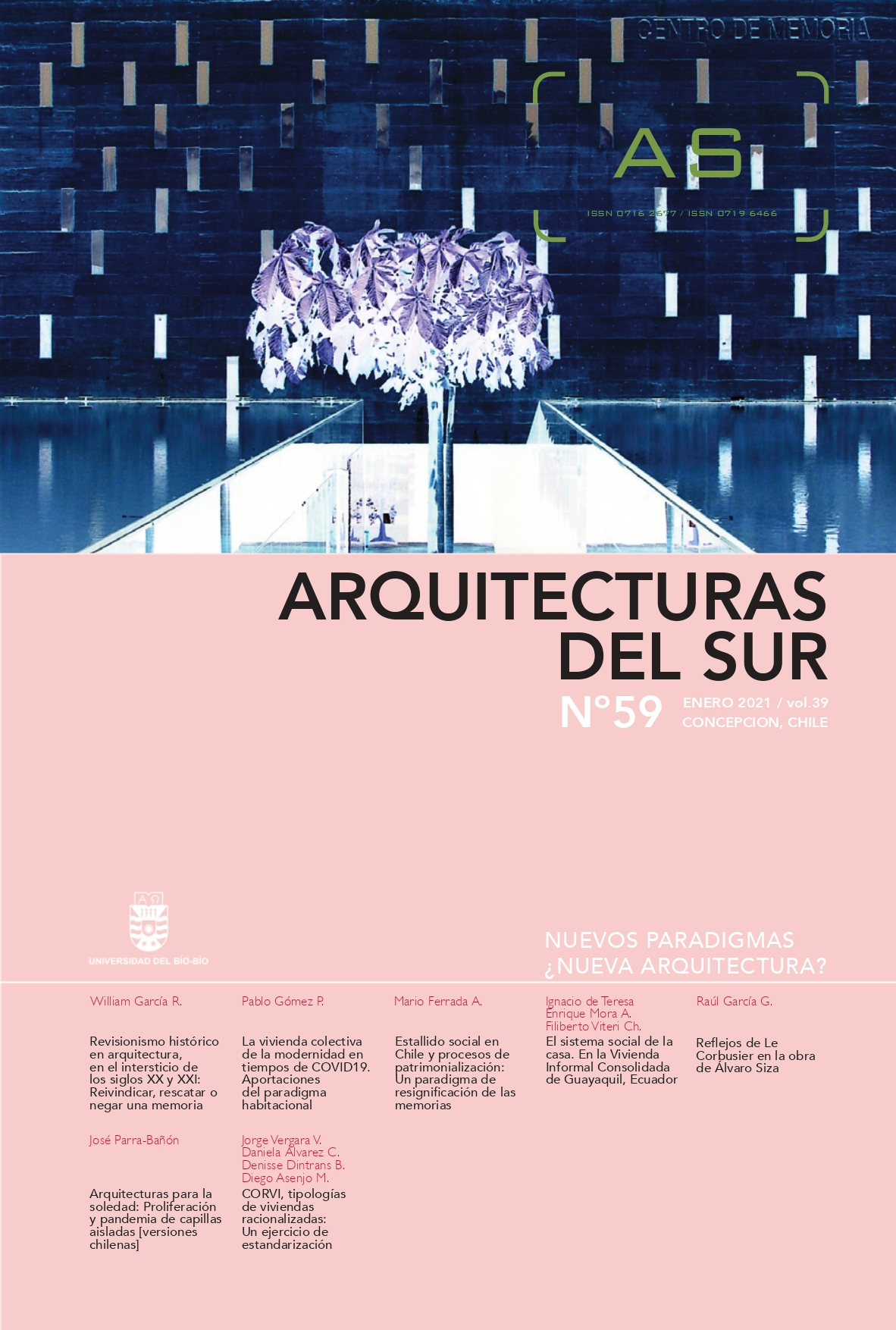CORVI, rationalized housing typologies: an exercise in standardization
DOI:
https://doi.org/10.22320/07196466.2021.39.059.07Keywords:
Typologies, housing, prototype, standardization, CORVIAbstract
The social housing designed by the teams of the Corporación de la Vivienda (CORVI) constitutes a material presence of enormous influence within Chilean society and within the community of architectural practices. This paper observes the work of these teams, by analyzing the information contained in the CORVI document called "Tipologías de viviendas racionalizadas 1966-1972 (Rationalized Housing Typologies 1966-1972)", which provides data on the shapes, dimensions, materials, and programs of eighteen housing typologies developed by the design teams between 1966 and 1971. Not all of these prototypes were built, but as a whole, it shows how the idea of social housing rationalization was conceived, and how it became an exercise in standardization, based on typologies, from which it is possible to learn both the forms of order and layout of everyday life that they propose, along with the interpretative flexibility used in their communication.
Downloads
References
AGUIRRE, B., CAÑAS, N., VERGARA, F. (2015). Sobre la arquitectura prefabricada en Chile 1960-1973. Revista de Diseño Urbano y Paisaje, (29), 34-51.
BENEVOLO, L. (1963). Historia de la Arquitectura Moderna. Madrid: Taurus.
Corporación de la Vivienda (CORVI) (1969). La Corporación de la Vivienda. Santiago de Chile: Oficina de Relaciones Públicas CORVI.
Corporación de la Vivienda (CORVI) (1972a). CORVI, en el centro de la producción. Revista Auca, 23, 40-67.
Corporación de la Vivienda (CORVI) (1972b). Tipologías de viviendas racionalizadas 1966-1972. Valparaíso: Subdepartamento de Diseño CORVI.
ESGUERRA, A. (2019). Future objects: tracing the socio-material politics of anticipation. Sustain Sci 14(4), 963–971. DOI: https://doi.org/10.1007/s11625-019-00670-3
GALAZ MANDAKOVIC, D. (2019). Edificios máquinas: Arquitectura Moderna y disciplinaria del Frente Popular en Tocopilla. AUS [Arquitectura / Urbanismo / Sustentabilidad], (26), 29-34. DOI:10.4206/aus.2019.n26-06
GÁMEZ, V. (1999). Algunos antecedentes para el estudio de la doctrina habitacional de la Corporación de la Vivienda. Revista INVI, 14(38), 27-58.
HÖLSCHER, L. (2019). Future pasts: about a form of thought in modern society. Sustain Sci, 14(4), 899–904. DOI: https://doi.org/10.1007/s11625-019-00678-9
HUGHES,T. (1989). The Evolution of Large Technological Systems. En: Bijker, W., Hughes, T. y Pinch, T. (eds.), The Social Construction of Technological Systems (pp.51-82). Cambridge: MIT Press.
LAMPLAND, M. Y STAR, S. L. (eds.) (2009). Standards and Their Stories: How Quantifying, Classifying, and Formalizing Practices Shape Everyday Life. Cornell University Press.
LATOUR, B. (1987). Science in Action: How to Follow Scientists and Engineers Through Society. Cambridge: Harvard University Press
LAW, J. Y MOL, A. (2020). Words to think with: An introduction. The Sociological Review, 68(2), 263–282. DOI: https://doi.org/10.1177/0038026120905452
LE CORBUSIER (1953). El Modulor. Ensayo sobre una medida armónica a la escala humana aplicable universalmente a la arquitectura y a la mecánica. Buenos Aires: Editorial Poseidon.
MONEO, R. (1978). On typology. Oppositions, 13, 22-45.
MONEO, R. (2015). Typology in the context of three projects: San Sebastian, Lacua, Aranjuez. The Journal of Architecture, 20(6), 1067-1087. DOI: 10.1080/13602365.2015.1116347
QUIROGA, H. (1972). Conclusiones. CORVI, en el centro de la producción. Revista Auca, (23), 64-65.
REDFIELD P. (2016). Fluid technologies: The Bush Pump, the LifeStraw and microworlds of humanitarian design. Social Studies of Science, 46(2), 159–183. DOI: https://doi.org/10.1177/0306312715620061
SEPÚLVEDA MELLADO, O., Y CARRASCO PEREZ, G. (1991). Reflexiones en torno a la producción serializada de viviendas sociales en Chile. Revista INVI, 6(13-14), 23-34.
STAR, S.L. (2002). Got Infrastructure? How Standards, Categories and Other Aspects of Infrastructure Influence Communication. The 2nd Social Study of IT workshop at the LSE ICT and Globalization, 22-23 April.
VERGARA VIDAL, J. (2017). Verticalización. La edificación en altura en la Región Metropolitana de Santiago (1990-2014). Revista INVI, 32(90), 9-49.
Downloads
Published
How to Cite
Issue
Section
License
Copyright (c) 2021 Jorge Eduardo Vergara-Vidal, Daniela Álvarez-Campos, Denisse Dintrans-Bauer, Diego Asenjo-Muñoz

This work is licensed under a Creative Commons Attribution-ShareAlike 4.0 International License.
The content of the articles published in each issue of Arquitecturas del Sur is the sole responsibility of the authors and does not necessarily represent the opinion of University of the Bío-Bío.
The authors will maintain their copyright; however, they will guarantee the journal the right to first publication and dissemination of their work. The publication of the article in Arquitecturas del Sur will be subject to the Creative Commons International license (CC BY-SA) that allows others to adapt: remix, transform and build on the material for any purpose, even commercially; share: copy and redistribute the material in any medium or format, as long as the authorship and first publication in this journal are acknowledged by citing them correctly, and their new contributions are under a license with the same terms.














 Programa de Información Científica/Concurso Fondos de Publicación de Revistas Científicas 2018/ Proyecto Mejoramiento de Visibilidad de Revistas UBB (Código:FP180007)
Programa de Información Científica/Concurso Fondos de Publicación de Revistas Científicas 2018/ Proyecto Mejoramiento de Visibilidad de Revistas UBB (Código:FP180007) 
